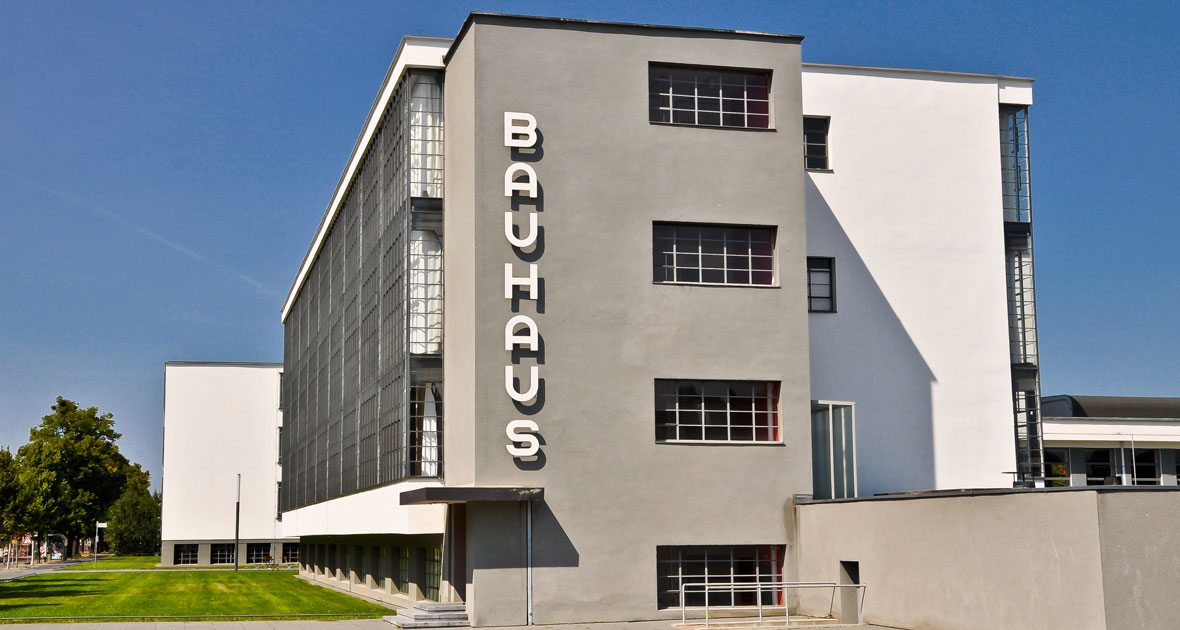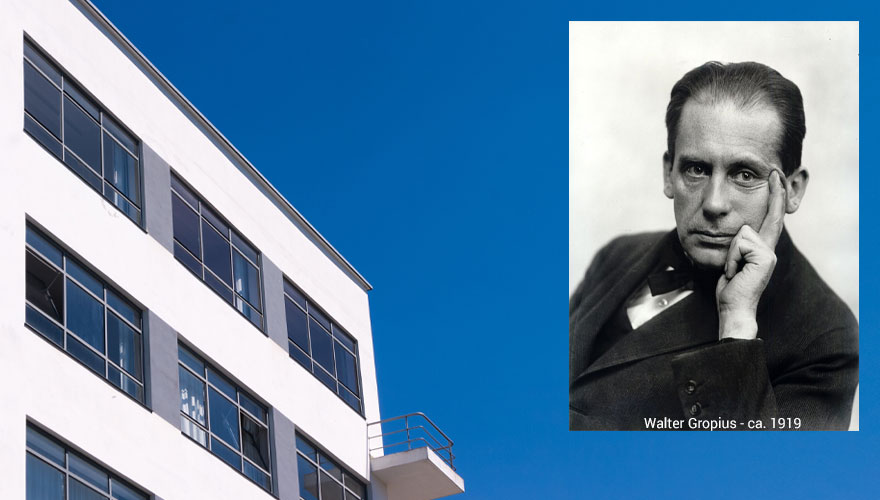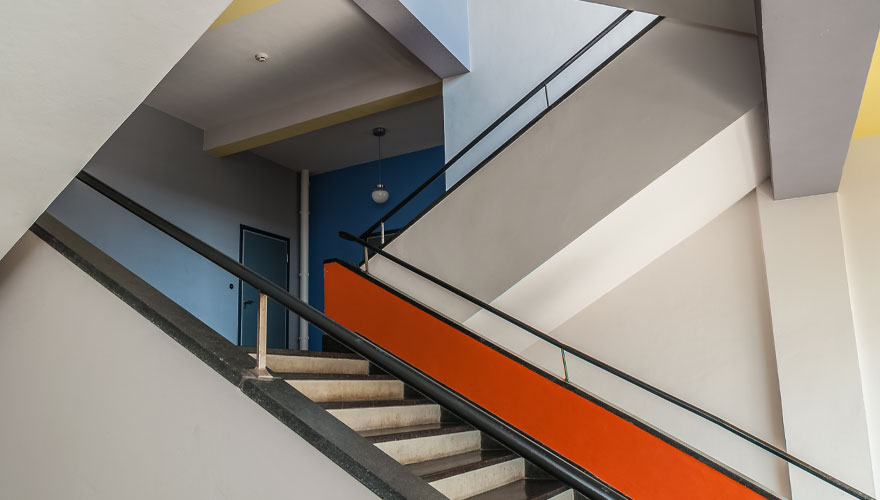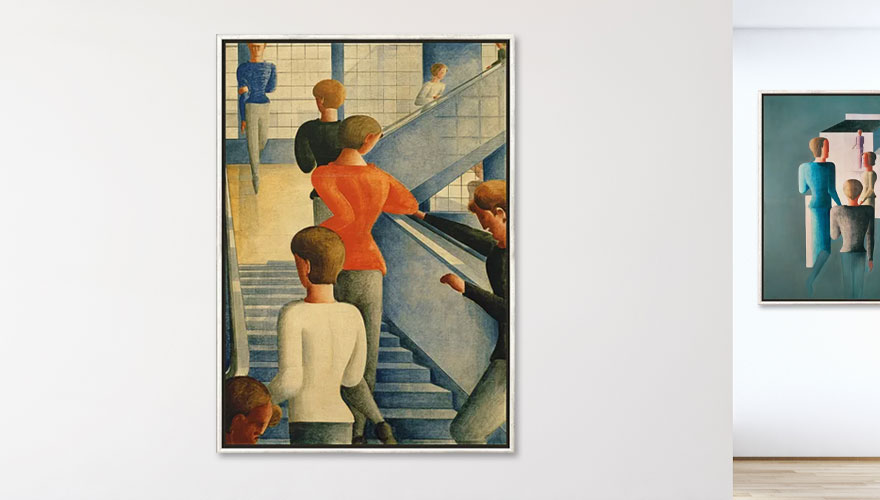
Bauhaus Art: The Pioneering Art School of Modernism
Bauhaus, the name now stands for a design that is both functional and aesthetic. The art school was founded in Weimar and existed for only 14 years, but it produced some of the most significant architectural, design and art concepts of the 20th century. The innovative approach of Bauhaus art attracted international students and artists and made Weimar, and later Dessau, into centres of the avant-garde. To this day, the Bauhaus philosophy has lost none of its relevance.
Bauhaus History: Three Directors and Three Locations
In 1919, Walter Gropius (1883-1969), an architect and industrial designer, laid the foundation for the legendary art school. He became renowned as a progressive mastermind of modern architecture even before the First World War. In 1919, he succeeded Henry van de Velde as director of the "Grand-Ducal Saxon College of Fine Arts" in Weimar. Here, he immediately implemented his idea of a progressive school of architecture, design, and art. He merged the college with the "Grand-Ducal School of Arts and Crafts" and created the "State Bauhaus in Weimar".
The first setback came in 1925 when the Thuringian state government cancelled all contracts with the Bauhaus a year earlier, and thus also the financial support. The Bauhaus was facing dissolution on 1 April 1925. However, it, fortunately, did not have to come to that: In March 1925, the Dessau municipal council decided to take over the Bauhaus as a municipal school, thus ensuring its continued existence.
This was followed three years later by the next turning point: Walter Gropius had shaped the work at the Bauhaus for nine years, and in 1928, he left the Bauhaus and handed over his responsibilities to Hannes Meyer (1889-1954). His term of office, however, lasted barely two years. Ludwig Mies van der Rohe (1886-1969) followed him in 1930. He had no choice but to move with the Bauhaus to Berlin for a few months in 1932 due to pressure from the National Socialists and finally dissolved it in 1933. Many masters and Bauhaus artists then left Germany and continued their work abroad.

The Bauhaus Reacted in its Concept to the Challenges of its Time
At the founding of the Bauhaus, its program was based on the ideas of Walter Gropius, who believed that a fundamental change in architecture, art, and craft was indispensable. In his manifesto titled "What is Architecture?", he attested that contemporary architecture was in a pitiful state. He saw only "deserts of ugliness" in the cities, with buildings that, as "spiritless mock-ups," bore "shameful evidence for posterity of the spiritual descent into hell of our generation." An improvement could only be achieved through a joint effort of architects, painters, sculptors, and craftsmen.
To achieve this, the traditional separation of art and craft had to be abolished. Gropius wrote: "Artists, let us at last break down the walls erected by our deforming academic training between the 'arts' and all of us become builders again! (...) Painters and sculptors, break through the barriers to architecture and become fellow builders, fellow strugglers for the final goal of art: the creative conception of the cathedral of the future." However, the work on content at the Bauhaus went even further. Closely connected to architectural modernization was the idea of social housing. In other words, the Bauhaus made housing policy.
Gropius designed workers' housing estates and called on his fellow architects to create affordable housing that was worth living in. High-quality articles of daily use were to become affordable for broad sections of the population. At the same time, the Bauhaus mobilized against housing shortages and rent-seeking.
However, the concepts and focal points of the Bauhaus did not remain static but changed continuously. Walter Gropius initiated another significant change of course. From 1922 onwards, he focused on dealing with the demands of industry and the resulting consequences for design. The new slogan was "Art and Technology - a New Unity". Whereby the aspect of machine production, in particular, influenced the work at the Bauhaus. The social aspects gained more importance, especially when the second director Hannes Meyer took office following the theme "People's Needs Instead of Luxury Needs". In contrast, the third director, Mies van der Rohe, once again placed greater emphasis on architecture that was intended to meet the highest aesthetic standards.

What Is Typical of Bauhaus Art?
The philosophy and goals of the Bauhaus had a direct influence on the design taught in the art school. The focus was always on the functionality of buildings and objects of daily use, later including the possibility of industrial production. However, the design was rarely a goal in itself and was largely subordinated to functionality. Large parts of Bauhaus products were therefore designed very functionally and with clear lines, without many ornaments, and extremely reduced in form and colour.
These simple and, at the same time, elegant artistic form concepts applied to both Bauhaus art and architecture and are today usually regarded as the characteristic Bauhaus style. But the design principles taught at the Bauhaus were far more diverse. Each of the "masters" at the art school brought in their impulses and ideas, which meant that the standards for design changed frequently. Thus, in addition to strict functionalism, other styles such as figuration, abstraction, expressionism, or surrealism flowed into the design concepts of the Bauhaus.

Teaching and Teachers at the Bauhaus
The Bauhaus represented a new beginning in theory, practice, and teaching. The Bauhaus differed fundamentally from all known art schools in terms of methodology, subjects, curricula, and overall organisation. In many cases, traditional teaching content was abandoned, and much more room was given to individual creativity. The teaching itself was characterised by the merging of art and craft postulated in Walter Gropius' program.
The Bauhaus pursued a very universal approach even when it came to theoretical instruction in painting and sculpture. Thus, at the beginning of the training, the basics of material properties, composition, and the theory of form and colour were taught. Later on, architectural instruction, the theory of proportions and the planning of urban districts, as well as engineering, psychology, and business administration were added to the curriculum. For the practical or craft aspects, there was a furniture workshop, a metal workshop, a weaving workshop, a printing workshop, a bookbinding workshop, pottery, a glazier's workshop, a workshop for wood and stone sculpture, and stage construction. In addition, there were classes for photography, typography, advertising, and light art.
However, Bauhaus art did not only take place within the school's walls; the students were actively involved in concrete building projects. The teaching staff was organized differently from traditional art academies. The training was not provided by professors but by so-called "masters of the craft" and "masters of the form". Most of the "masters of the form" were painters and sculptors, including many well-known names of classical modernism. Oskar Schlemmer, Lyonel Feininger, Wassily Kandinsky, Lászlo Moholy-Nagy, Paul Klee, and Marianne Brandt, among others, worked as Bauhaus artists. Among the students, the progressive approach to teaching was met with great interest. Students from around 30 nations were to complete the Bauhaus programme over 14 years.
The Style and Concept of the Bauhaus are Still Current
Even though the Bauhaus had to close in 1933, both its spirit and design can still be felt and seen in many places today. Periodically, simple design based on the principles of the Bauhaus philosophy experiences a renaissance. Particularly in the area of energy- and resource-saving construction methods, the guiding principle "Form follows Function" seems to be regaining importance in current architecture. The questions and demands of the Bauhaus concerning housing policy are more relevant today than ever before.
However, the art school is persistently present in the collective consciousness not least because of the numerous Bauhaus-style buildings that can be found throughout Germany, for example, in Stuttgart or Karlsruhe. In addition, various institutions and academic establishments keep the legacy of Bauhaus art alive, for example, the "Bauhaus Dessau Foundation" or the Bauhaus Archive in Berlin.
In 1996, UNESCO recognised the role of the Bauhaus in architectural history and declared the Bauhaus sites in Weimar and Dessau World Heritage Sites. The Bauhaus was once again brought to the public's attention in 2019 when it celebrated the 100th anniversary of its founding. To mark this occasion, there were exhibitions, and work shows on the subject worldwide. The international and interdisciplinary research and exhibition project "bauhaus imaginista", for example, examined how the pedagogy and design ideas of the Bauhaus were taken up and further developed all over the world.
